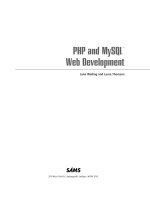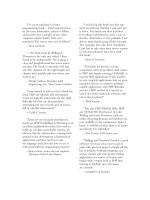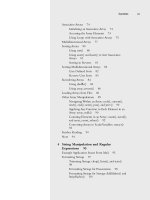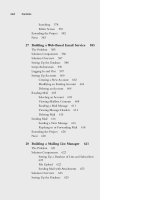PHP and MySQL Web Development - P35 pdf
Bạn đang xem bản rút gọn của tài liệu. Xem và tải ngay bản đầy đủ của tài liệu tại đây (73.6 KB, 5 trang )
137
Pass by Reference Versus Pass by Value
inside the function, $var = contents
outside the function, $var = contents
Note that the variable is in scope from the point in which the line global $var; is
executed.We could have declared the function above or below where we call it. (Note
that function scope is quite different from variable scope!) The location of the function
declaration is inconsequential, what is important is where we call the function and there-
fore execute the code within it.
You can also use the global keyword at the top of a script when a variable is first
used to declare that it should be in scope throughout the script.This is possibly a more
common use of the global keyword.
You can see from the preceding examples that it is perfectly legal to reuse a variable
name for a variable inside and outside a function without interference between the two.
It is generally a bad idea however because without carefully reading the code and think-
ing about scope, people might assume that the variables are one and the same.
Pass by Reference Versus Pass by Value
If we want to write a function called increment() that allows us to increment a value,
we might be tempted to try writing it as follows:
function increment($value, $amount = 1)
{
$value = $value +$amount;
}
This code will be of no use.The output from the following test code will be "10".
$value = 10;
increment ($value);
echo $value;
The contents of $value have not changed.
This is because of the scope rules.This code creates a variable called $value which
contains 10. It then calls the function increment().The variable $value in the function
is created when the function is called. One is added to it, so the value of
$value is 11
inside the function, until the function ends, and we return to the code that called it. In
this code, the variable $value is a different variable, with global scope, and therefore
unchanged.
One way of overcoming this is to declare $value in the function as global, but this
means that in order to use this function, the variable that we wanted to increment would
need to be named $value.A better approach would be to use pass by reference.
The normal way that function parameters are called is called pass by value.When you
pass a parameter, a new variable is created which contains the value passed in. It is a copy
of the original.You are free to modify this value in any way, but the value of the original
variable outside the function remains unchanged.
07 525x ch05 1/24/03 3:36 PM Page 137
138
Chapter 5 Reusing Code and Writing Functions
The better approach is to use pass by reference. Here, when a parameter is passed to a
function, rather than creating a new variable, the function receives a reference to the
original variable.This reference has a variable name, beginning with a dollar sign, and
can be used in exactly the same way as another variable.The difference is that rather
than having a value of its own, it merely refers to the original. Any modifications made
to the reference also affect the original.
We specify that a parameter is to use pass by reference by placing an ampersand (&)
before the parameter name in the function’s definition. No change is required in the
function call.
The preceding increment() example can be modified to have one parameter passed
by reference, and it will work correctly.
function increment(&$value, $amount = 1)
{
$value = $value +$amount;
}
We now have a working function, and are free to name the variable we want to incre-
ment anything we like.As already mentioned, it is confusing to humans to use the same
name inside and outside a function, so we will give the variable in the main script a new
name.The following test code will now echo 10 before the call to increment(), and 11
afterwards.
$a = 10;
echo $a.'<br />';
increment ($a);
echo $a.'<br />';
Returning from Functions
The keyword return stops the execution of a function.When a function ends because
either all statements have been executed or the keyword return is used, execution returns
to the statement after the function call.
If you call the following function, only the first echo statement will be executed.
function test_return()
{
echo 'This statement will be executed';
return;
echo 'This statement will never be executed';
}
Obviously, this is not a very useful way to use return. Normally, you will only want to
return from the middle of a function in response to a condition being met.
07 525x ch05 1/24/03 3:36 PM Page 138
139
Returning Values from Functions
An error condition is a common reason to use a return statement to stop execution
of a function before the end. If, for instance, you wrote a function to find out which of
two numbers was greater, you might want to exit if any of the numbers were missing.
function larger( $x, $y )
{
if (!isset($x)||!isset($y))
{
echo 'This function requires two numbers';
return;
}
if ($x>=$y)
echo $x;
else
echo $y;
echo '<br />';
}
The built-in function isset() tells you whether a variable has been created and given a
value. In this code, we are going to give an error message and return if either of the
parameters has not been set with a value.We test this by using !isset(),meaning
“NOT isset(),” so the if statement can be read as “if x is not set or if y is not set”.The
function will return if either of these conditions is true.
If the
return statement is executed, the subsequent lines of code in the function will
be ignored. Program execution will return to the point at which the function was called.
If both parameters are set, the function will echo the larger of the two.
The output from the following code:
$a = 1;
$b = 2.5;
$c = 1.9;
larger($a, $b);
larger($c, $a);
larger($d, $a);
will be as follows:
2.5
1.9
This function requires two numbers
Returning Values from Functions
Exiting from a function is not the only reason to use return. Many functions use
return statements to communicate with the code that called them. Rather than echoing
the result of the comparison in our larger() function, our function might have been
07 525x ch05 1/24/03 3:36 PM Page 139
140
Chapter 5 Reusing Code and Writing Functions
more useful if we returned the answer.This way, the code that called the function can
choose if and how to display or use it.The equivalent built-in function max() behaves in
this way.
We can write our larger() function as follows:
function larger ($x, $y)
{
if (!isset($x)||!isset($y))
return false;
else if ($x>=$y)
return $x;
else
return $y;
}
Here we are returning the larger of the two values passed in.We will return an obviously
different value in the case of an error. If one of the numbers is missing, we will return
false.The only caveat with this approach is that programmers calling the function must
test the return type with === to make sure that false is not confused with 0.
For comparison, the built-in function max() returns nothing if both variables are not
set, and if only one was set, returns that one.
The following code:
$a = 1; $b = 2.5; $c = 1.9;
echo larger($a, $b)."<br />";
echo larger($c, $a)."<br />";
echo larger($d, $a)."<br />";
will produce this output because $d does not exist and false is not visible:
2.5
1.9
Functions that perform some task, but do not need to return a value, often return true
or false to indicate if they succeeded or failed.The boolean values true and false can
be represented with integer values 1 and 0 respectively, although they are of different
types.
Code Blocks
We declare that a group of statements are a block by placing them within curly braces.
This does not affect most of the operation of your code, but has specific implications
including the way control structures such as loops and conditionals execute.
The following two examples work very differently:
07 525x ch05 1/24/03 3:36 PM Page 140
141
Recursion
Example Without Code Block
for($i = 0; $i < 3; $i++ )
echo 'Line 1<br />';
echo 'Line 2<br />';
Example with Code Block
for($i = 0; $i < 3; $i++ )
{
echo 'Line 1<br />';
echo 'Line 2<br />';
}
In both examples, the for loop is iterated through three times. In the first example, only
the single line directly below this is executed by the for loop.The output from this
example is as follows:
Line 1
Line 1
Line 1
Line 2
The second example uses a code block to group two lines together.This means that both
lines are executed three times by the for loop.The output from this example is as fol-
lows:
Line 1
Line 2
Line 1
Line 2
Line 1
Line 2
Because the code in these examples is properly indented, you can probably see the dif-
ference between them at a glance.The indenting of the code is intended to give readers
a visual interpretation of what lines are affected by the
for loop. However, note that
spaces do not affect how PHP processes the code.
In some languages, code blocks affect variable scope.This is not the case in PHP.
Recursion
Recursive functions are supported in PHP. A recursive function is one that calls itself.These
functions are particularly useful for navigating dynamic data structures such as linked lists
and trees.
However, few Web-based applications require a data structure of this complexity, and
so we have minimal use for recursion. Recursion can be used instead of iteration in
many cases because both of these allow you to do something repetitively. Recursive
07 525x ch05 1/24/03 3:36 PM Page 141









